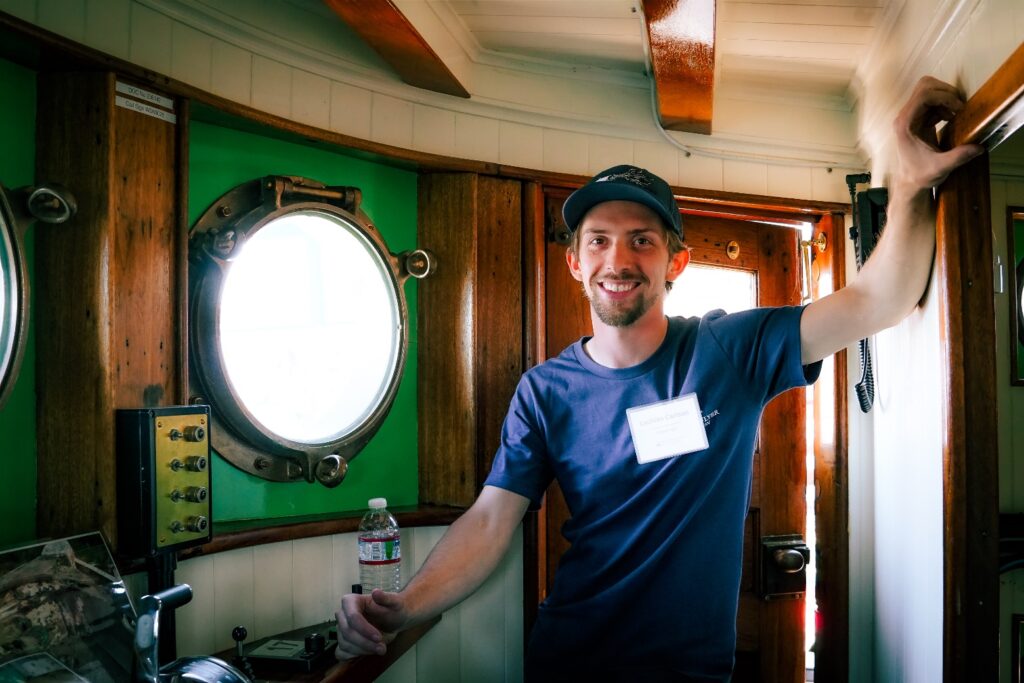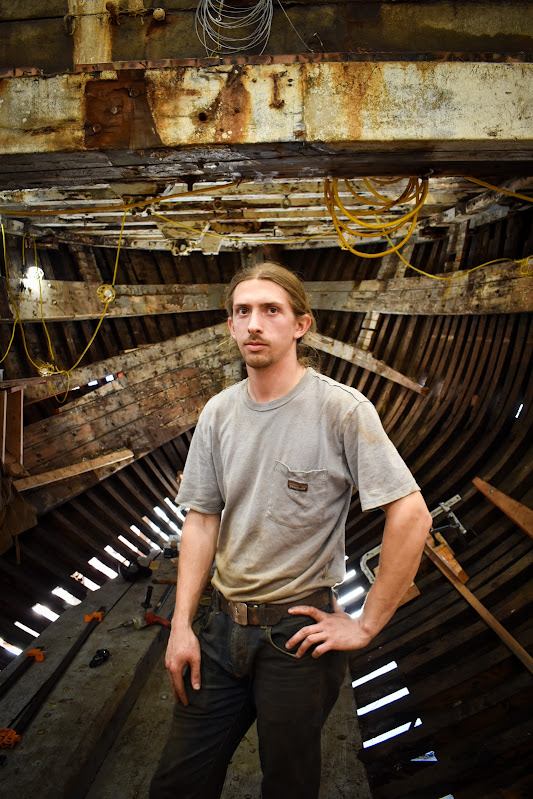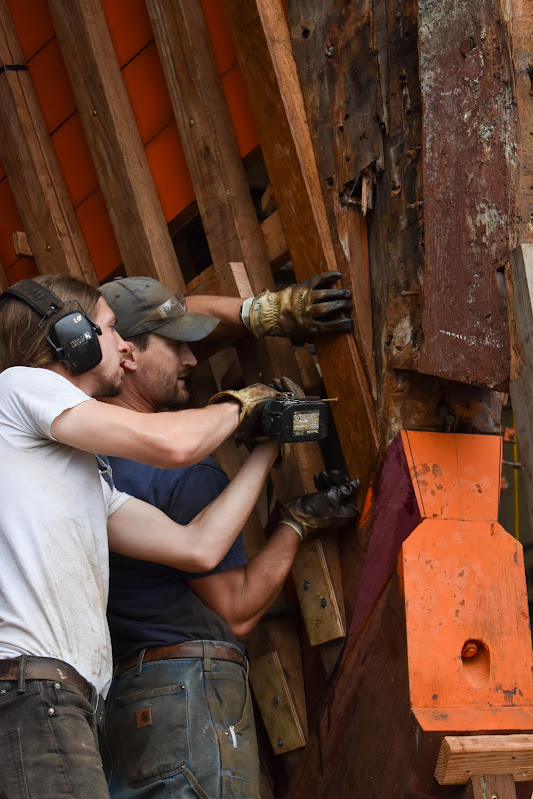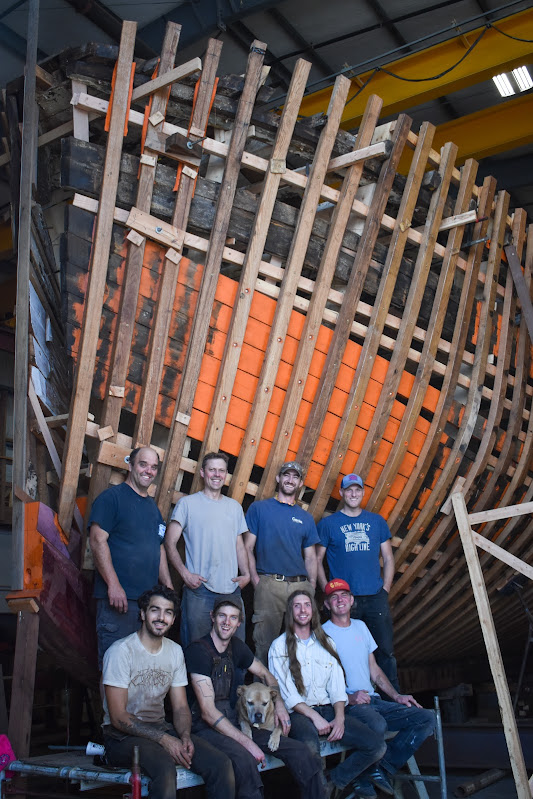
This month we said a fond goodbye and thank you to shipwright Lachlan Carlson, who has been applying his woodworking skills to the Western Flyer for the past five years. Lachlan will be returning to Washington, where he’ll be doing more custom carpentry and boat work. As his time with the Flyer came to an end, we sat down to hear his reflections about his time on the project.
Thank you, Lachlan—we look forward to seeing you during the Flyer’s next trip to the Pacific Northwest!
* * *
26-year-old Lachlan Carlson grew up in Ballard, a neighborhood along the Seattle waterfront. Asked about his current profession, he describes himself as “a shipwright, or marine carpenter…or a fine woodworker.” In fact, the high quality of the best shipboard woodworking is what drew him to boats in the first place.

“I took woodshop at one of the only schools in Seattle that still offered woodshop—I started sophomore year and loved it,” he says. “I was going to go to this cabinetry program in Seattle. But then I toured the [Northwest School of Wooden Boat Building], and I was set. It was like, ‘This is the school. This is the place where I want to learn.’ It’s not even that it was wooden boats—that was cool, but I could see this was the best place to just improve your skill set to be a woodworker, regardless of it being boats or not.”
In a way, Lachlan’s path to working on boats reminds me of that followed by Tex Travis, the Western Flyer’s engineer during the 1940 expedition. Like Lachlan, he began with a passion for a particular craft—in Tex’s case, for working on Diesel engines, which Steinbeck and Ricketts thought “appealed to some sense of neat thinking in Tex...[being] so simple and powerful, blocks of pure logic in shining metal.”
“By an accident, possibly alcoholic,” Steinbeck recounted, “[Tex] came to the Coast in an old Ford and sat down beside the Bay, and there he discovered a wonderful thing. Here, combined in one, were the best Diesels to be found anywhere, and boats. He never recovered from his shocked pleasure. He could never leave the sea again, for nowhere else could he find these two perfect things in one.”
To hone his own skills, Lachlan undertook what amounted to a modern-day apprenticeship from 8 to 5 every day. He loved the work and the blend of people at the school, finding the age range of his fellow students—anywhere from 17 to about 75—particularly striking and a sign that this was a place for people who loved their work, who had decided never to go on autopilot. Thanks in part to a dedicated mentor and a final-quarter focus on restoration, working on boats for its own sake started to pull him in. A mentor connected him to local boatyards for interviews, and one of the first places he applied to was the Port Townsend Shipwrights Co-Op—a highly respected team and then the new home to the Flyer.

“This was 2016, 2017,” he remembers. “And at that point, the Flyer had not been worked on at all, but it was in the building. Nothing around it. Totally bare. I’m videotaping the Flyer—I don’t even know anything about the boat. Literally nothing about it. And my buddy, I can hear him in the back–‘This is the boat that John Steinbeck sailed on in The Log from the Sea of Cortez’, and I’m like, ‘Cool. I don’t know what that means.’” He laughs.
But he could see the high quality of the work in the yard—and could feel the eagerness of the entire crew to work on the Western Flyer. He jumped at the chance to join the team, sticking through the first couple of years of work that he’d been told straight out would be “mostly plywood.” The first thing he did was sandblast an intake reservoir called a sea chest, a process that kept him in a claustrophobically small tube with sand pouring down over his face. Steel, aluminum—everything, it seemed, but wood.
But woodworking lay ahead—and the Flyer, most of all. “A project of that scale, what we’re going to do, doesn’t happen, really,” Lachlan reflects. “For most of us, that’s a once-in-a-lifetime project. It’s expensive. It’s impractical. Most people, if they’re going to go to that expense to build a boat that big, they’re going to build a new boat and they’re going to build it out of steel. But this project is different, right? Wood boats are such a romantic idea.”
Of all the work Lachlan’s done on the project, the pieces that stand out are the framing and the stem. The framing was pure teamwork, requiring precise coordination and a dialed-in crew. “Everyone’s head’s gotta be on a swivel,” Lachlan recalls. “Everyone’s gotta be tuned in. And [hopefully] you get into a rhythm…and everyone’s like dialed into what they need to do. And there were some times when you wouldn’t really have to talk. You would be getting frames steamed in the boat, and you’d go, ‘Oh wow, we didn’t have to communicate…we all knew what to do.’ You don’t even have to talk about it. That was really special.”

Then there was the stem: the curved timber rising from the keel at the very bow, where the hull’s starboard and port planking meet, and Lachlan’s single favorite piece of the project. “It’s incredibly integral to the boat. It’s gonna be getting all the waves. And they can be fairly complex and require a lot of planning to make them right. It’s really cool to plan out such a big piece of wood and carve the whole thing to your pattern, and trust your abilities–this is how it’s supposed to be. This is how it’s going to work.”
Now, with the hull fully ocean-tested and the Flyer back in Monterey Bay at a Moss Landing berth, Lachlan reflects on the end of his time on the project. “I have to catch myself sometimes,” he says. I’ll just be working and think, You know what? This is pretty incredible. The number of people that I’ve interacted with who’ve really connected with the boat…it’s a privilege to work on something that’s so special to so many people.”
Posted in Blog